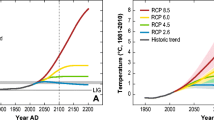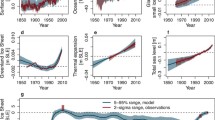Abstract
Anthropogenic sea-level rise (SLR) causes considerable risks. Designing a sound SLR risk-management strategy requires careful consideration of decision-relevant uncertainties such as the reasonable upper bound of future SLR. The recent Intergovernmental Panel on Climate Change’s (IPCC) Fourth Assessment reported a likely upper SLR bound in the year 2100 near 0.6 m (meter). More recent studies considering semi-empirical modeling approaches and kinematic constraints on glacial melting suggest a reasonable 2100 SLR upper bound of approximately 2 m. These recent studies have broken important new ground, but they largely neglect uncertainties surrounding thermal expansion (thermosteric SLR) and/or observational constraints on ocean heat uptake. Here we quantify the effects of key parametric uncertainties and observational constraints on thermosteric SLR projections using an Earth system model with a dynamic three-dimensional ocean, which provides a mechanistic representation of deep ocean processes and heat uptake. Considering these effects nearly doubles the contribution of thermosteric SLR compared to previous estimates and increases the reasonable upper bound of 2100 SLR projections by 0.25 m. As an illustrative example of the effect of overconfidence, we show how neglecting thermosteric uncertainty in projections of the SLR upper bound can considerably bias risk analysis and hence the design of adaptation strategies. For conditions close to the Port of Los Angeles, the 0.25 m increase in the reasonable upper bound can result in a flooding-risk increase by roughly three orders of magnitude. Results provide evidence that relatively minor underestimation of the upper bound of projected SLR can lead to major downward biases of future flooding risks.



Similar content being viewed by others
References
Alley RB, Joughin I (2012) Modeling Ice-Sheet Flow. Science 336(6081):551–552
Caldwell P (2010) Joint Archive for Sea Level: Research Quality Data. (University of Hawaii, Honolulu), http://uhslc.soest.hawaii.edu/jasl.html
Domingues CM, Church JA, White NJ, Gleckler PJ, Wijffels SE, Barker PM, Dunn JR (2008) Improved estimates of upper-ocean warming and multi-decadal sea-level rise. Nature 453(7198):1090–1096
Goes M, Urban NM, Tonkonojenkov R, Haran M, Schmittner A, Keller K (2010) What is the skill of ocean tracers in reducing uncertainties about ocean diapycnal mixing and projections of the Atlantic Meridional Overturning Circulation? J Geophys Res-Oceans. doi:10.1029/2010JC006407
Hegerl GC, Zwiers FW, Braconnot P, Gillett NP, Luo Y, Marengo Orsini JA, Nicholls N, Penner JE, Stott PA (2007) Understanding and attributing climate change. In: Solomon S, Qin D, Manning M, Chen Z, Marquis M, Averyt KB, Tignor M, Miller HL (eds) Climate Change 2007: The Physical Science Basis. Contribution of Working Group I to the Fourth Assessment Report of the Intergovernmental Panel on Climate Change. Cambridge University Press, Cambridge, United Kingdom and New York, NY, USA
Hunter J (2011) A simple technique for estimating an allowance for uncertain sea-level rise. Clim Change. doi:10.1007/s10584-10011-10332-10581
IPCC (2007) Summary for policymakers. In: Solomon S, Qin D, Manning M, Chen Z, Marquis M, Averyt KB, Tignor M, Miller HL (eds) Climate change 2007: The physical science basis. Contribution of working group I to the fourth assessment report of the intergovernmental panel on climate change. Cambridge University Press, Cambridge, United Kingdom and New York, NY, USA
Jacob T, Wahr J, Pfeffer WT, Swenson S (2012) Recent contributions of glaciers and ice caps to sea level rise. Nature 482(7386):514–518
Jevrejeva S, Moore JC, Grinsted A (2010) How will sea level respond to changes in natural and anthropogenic forcings by 2100? Geophys Res Lett. doi:10.1029/2010GL042947
Knutti R, Hegerl GC (2008) The equilibrium sensitivity of the Earth’s temperature to radiation changes. Nat Geosc 1(11):735–743
Knutti R, Stocker TF (2000) Influence of the thermohaline circulation on projected sea level rise. J Clim 13:1997–2001
Knutti R, Stocker TF, Joos F, Plattner GK (2002) Constraints on radiative forcing and future climate change from observations and climate model ensembles. Nature 416(6882):719–723
Lempert R, Sriver RL, Keller K (2012) Characterizing Uncertain Sea Level Rise Projections to Support Infrastructure Investment Decisions. California Energy Commission, Publication Number: CEC-500-2012-056, http://www.energy.ca.gov/2012publications/CEC-500-2012-056/CEC-500-2012-056.pdf. In review at Global Environmental Change
Lin N, Emanuel K, Oppenheimer M, Vanmarcke E (2012) Physically based assessment of hurricane surge threat under climate change. Nature Climate Change. doi:10.1038/NCLIMATE1389
McDougall TJ, Jackett DR, Wright DG, Feistel R (2003) Accurate and computationally efficient algorithms for potential temperature and density of seawater. J Atmos Ocean Technol 20(5):730–741
Meehl GA, Stocker TF, Collins WD, Friedlingstein P, Gaye AT, Gregory JM, Kitoh A, Knutti R, Murphy JM, Noda A, Raper SCB, Watterson IG, Weaver AJ, Zhao Z-C (2007) Global climate projections. In: Solomon S, Qin D, Manning M, Chen Z, Marquis M, Averyt KB, Tignor M, Miller HL (eds) Climate change 2007: The physical science basis. Contribution of working group I to the fourth assessment report of the intergovernmental panel on climate change. Cambridge University Press, Cambridge, United Kingdom and New York, NY, USA
Milne GA, Gehrels WR, Hughes CW, Tamisiea ME (2009) Identifying the causes of sea-level change. Nat Geosci 2(7):471–478
Moon T, Joughin I, Smith B, Howat I (2012) 21st-Century Evolution of Greenland Outlet Glacier Velocities. Science 336(6081):576–578
Moss RH, Edmonds JA, Hibbard KA, Manning MR, Rose SK, van Vuuren DP, Carter TR, Emori S, Kainuma M, Kram T, Meehl GA, Mitchell JFB, Nakicenovic N, Riahi K, Smith SJ, Stouffer RJ, Thomson AM, Weyant JP, Wilbanks TJ (2010) The next generation of scenarios for climate change research and assessment. Nature 463(7282):747–756
National Academy of Sciences (2010) Adapting to the Impacts of Climate Change. The National Academies Press, Washington
Nicholls RJ, Marinova N, Lowe JA, Brown S, Vellinga P, De Gusmao D, Hinkel J, Tol RSJ (2011) Sea-level rise and its possible impacts given a ‘beyond 4 degrees C world’ in the twenty-first century. Phil Trans R Soc. doi:10.1098/rsta.2010.0291
Olson R, Sriver RL, Goes M, Urban NM, Matthews HD, Haran M, Keller K (2012) A climate sensitivity estimate using Bayesian fusion of instrumental observations and an Earth System model. J Geophys Res-Atm D04103. doi:04110.01029/02011JD016620
Pfeffer WT, Harper JT, O’Neel S (2008) Kinematic constraints on glacier contributions to 21st-century sea-level rise. Science 321:1340–1343
Purvis MJ, Bates PD, Hayes CM (2008) A probabilistic methodology to estimate future coastal flood risk due to sea level rise. Coast Eng 55(12):1062–1073
Randall DA, Wood RA, Bony S, Colman R, Fichefet T, Fyfe J, Kattsov V, Pitman A, Shukla J, Srinivasan J, Stouffer RJ, Sumi A, Taylor KE (2007) Climate models and their evaluation. In: Solomon S, Qin D, Manning M, Chen Z, Marquis M, Averyt KB, Tignor M, Miller HL (eds) Climate change 2007: The physical science basis. Contribution of working group I to the fourth assessment report of the intergovernmental panel on climate change. Cambridge University Press, Cambridge, United Kingdom and New York, NY, USA
Titus JG, Narayanan V (1995) The probability of sea level rise. United States Environmental Protection Agency
Tol RSJ, Bohn M, Downing TE, Guillerminet M-L, Hizsnyik E, Kasperson R, Lonsdale K, Mays C, Nicholls RJ, Olsthoorn AA, Pfeifle G, Poumadere M, Toth FL, Nafeidis AT, Van Der Werrf PE, Yetkiner IH (2006) Adaptation to five metres of sea level rise. J Risk Res 9(5):467–482
van Dantzig D (1956) Economic decision problems for flood prevention. Econometrica 24(3):276–287
Vellinga P, Katsman C, Sterl A, Beersma J, Hazeleger W, Church J, Kopp R, Kroon D, Oppenheimer M, Plag H-P, Rahmstor S, Lowe J, Ridley J, von Storch H, Vaughan D, van de Wal R, Weisse R, Kwadijk J, Lammersen R, Marinova N (2009) Exploring high-end climate change scenarios for flood protection of the Netherlands, http://www.knmi.nl/bibliotheek/knmipubWR/WR2009-05.pdf
Vermeer M, Rahmstorf S (2009) Global sea level linked to global temperature. Proc Natl Acad Sci USA 106(51):21527–21532
Wanninkhof R (1992) Relationship between wind speed and gas exchange over the ocean. J Geophys Res 97:7373–7382
Weaver AJ et al (2001) The UVic Earth System Climate Model: Model description, climatology, and applications to past, present and future climates. Atmosphere-Ocean 39(4):361–428
Willis JK, Church JA (2012) Regional Sea-Level Projection. Science 336(6081):550–551
Yin JJ, Schlesinger ME, Stouffer RJ (2009) Model projections of rapid sea-level rise on the northeast coast of the United States. Nat Geosci 2(4):262–266
Yohe G, Neumann J, Marshall P, Ameden H (1996) The economic cost of greenhouse-induced sea-level rise for developed property in the United States. Clim Change 32:387–410
Acknowledgements
This study was partially supported by the National Science Foundation (SES-1049208) and the Penn State Center for Climate Risk Management. The authors acknowledge helpful discussions with Robert Lempert, Nancy Tuana, Patrick Applegate, Michael Oppenheimer, Gary Yohe, Richard Alley, and Don Wuebbles. All errors and opinions are ours.
Author information
Authors and Affiliations
Corresponding author
Rights and permissions
About this article
Cite this article
Sriver, R.L., Urban, N.M., Olson, R. et al. Toward a physically plausible upper bound of sea-level rise projections. Climatic Change 115, 893–902 (2012). https://doi.org/10.1007/s10584-012-0610-6
Received:
Accepted:
Published:
Issue Date:
DOI: https://doi.org/10.1007/s10584-012-0610-6




